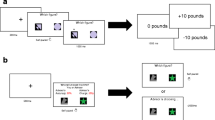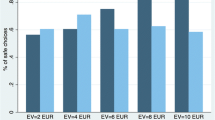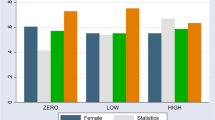Abstract
We investigate how choices for uncertain gain and loss prospects are affected by the decision maker’s perceived level of knowledge about the underlying domain of uncertainty. Specifically, we test whether Heath and Tversky’s (J Risk Uncertain 4:5–28, 1991) competence hypothesis extends from gains to losses. We predict that the commonly-observed preference for high knowledge over low knowledge prospects for gains reverses for losses. We employ an empirical setup in which participants make hypothetical choices between gain or loss prospects in which the outcome depends on whether a high or low knowledge event occurs. We infer decision weighting functions for high and low knowledge events from choices using a representative agent preference model. For gains, we replicate the results of Kilka and Weber (Manage Sci 47:1712–1726, 2001), finding that decision makers are more attracted to choices that they feel more knowledgeable about. However, for losses, we find limited support for our extension of the competence effect.



Similar content being viewed by others
Notes
Machina (2009) presented a four-color generalization of the Ellsberg Paradox that violates expected utility, as well as Choquet expected utility. Baillon et al. (forthcoming) showed that this counter-example violates most existing models of ambiguity as well.
Wu and Gonzalez (1999) showed that the weighting function satisfies a stronger property for gains, concavity for low probability events and convexity for high probability events.
Support theory allows nonadditive probability judgments, P(A ∪ A′) ≤ P(A) + P(A′). There are other hypotheses besides binary complementarity that follow from support theory, such as proportionality, product rule, and unpacking principle. However, binary complementarity is the only one that our design permits us to test.
Full instructions and program code are available upon request.
The same basic findings discussed below hold if we use different criteria to distinguish between low and high knowledge domains.
We also computed Pearson statistics and found similar results.
We also produced similar results using Prelec’s (1998) two-parameter function.
We also performed an additional estimation, restricting the sample of the observations in which the reported knowledge difference exceeded 3, leaving us with 468 of 1,284 observation. This analysis produced qualitatively similar results (Gains: Δi ≈ 0.50, p < 0.001; Losses: Δi ≈ − 0.05, n.s.).
We also compared expected utility to our more general model. The expected utility restriction was conducted by setting all parameters equal to 1. A likelihood ratio test strongly rejected the expected utility model for both gains and losses.
References
Abdellaoui, M. (2000). Parameter-free elicitation of utility and probability weighting functions. Management Science, 46, 1497–1512.
Abdellaoui, M., Vossmann, F., & Weber, M. (2005). Choice-based elicitation and decomposition of decision weights for gains and losses under uncertainty. Management Science, 51, 1384–1399.
Abdellaoui, M., Bleichrodt, H., & Paraschiv, C. (2007). Measuring loss aversion: A parameter-free approach. Management Science, 53, 1659–1674.
Ballinger, T. P., & Wilcox, N. T. (1997). Decisions, error and heterogeneity. Economic Journal, 106, 1090–1105.
Baillon, A., l’Haridon, O., & Placido, L. (forthcoming). Ambiguity Models and the Machina Paradox. American Economic Review.
Basili, M., Chateauneuf, A., & Fontini, F. (2005). Choices under ambiguity with familiar and unfamiliar outcomes. Theory and Decision, 58, 195–207.
Becker, S. W., & Brownson, F. O. (1964). What price ambiguity? Or the role of ambiguity in decision-making. Journal of Political Economy, 72, 62–73.
Bettman, J. R., Luce, M. F., & Payne, J. W. (1998). Constructive consumer choice processes. Journal of Consumer Research, 25, 187–217.
Birnbaum, M. H., & McIntosh, W. R. (1996). Violations of branch independence in choices between gambles. Organizational Behavior and Human Decision Processes, 67, 91–110.
Blavatskyy, P. (2007). Stochastic expected utility theory. Journal of Risk and Uncertainty, 34, 259–286.
Brenner, L. A., & Rottenstreich, Y. (1999). Focus, repacking, and the judgment of grouped hypotheses. Journal of Behavioral Decision Making, 12, 141–148.
Camerer, C. F., & Ho, T.-H. (1994). Violations of the betweenness axiom and nonlinearity in probability. Journal of Risk and Uncertainty, 8, 167–196.
Camerer, C. F., & Hogarth, R. (1999). The effects of financial incentives in experiments: A review and capital–labor–production framework. Journal of Risk and Uncertainty, 3, 7–42.
Camerer, C. F., & Weber, M. (1992). Recent developments in modeling preferences: Uncertainty and ambiguity. Journal of Risk and Uncertainty, 5, 325–370.
Choquet, G. (1954). Theory of capacities. Annales de l’Institut Fourier, 5, 131–295.
Chow, C. C., & Sarin, R. K. (2001). Comparative ignorance and the Ellsberg paradox. Journal of Risk and Uncertainty, 2, 129–139.
Cohen, M., Jaffray, J.-Y., & Said, T. (1985). Individual behavior under risk and under uncertainty: An experimental study. Theory and Decision, 18, 203–228.
de Bruin, W. B., Fischhoff, B., Millstein, S. G., & Halpern-Felsher, B. L. (2000). Verbal and numerical expressions of probability: ‘It’s a fifty-fifty chance’. Organizational Behavior and Human Decision Processes, 81, 115–131.
Dickhaut, J., McCabe, K., Nagode, J. C., Rustichini, A., Smith, K., & Pardo, J. V. (2003). The impact of the certainty context on the process of choice. Proceedings of the National Academy of Sciences of the United States of America, 100, 3536–3541.
Einhorn, H. J., & Hogarth, R. M. (1986). Decision making under ambiguity. Journal of Business, 59, S225–S250.
Ellsberg, D. (1961). Risk, ambiguity and the Savage axioms. Quarterly Journal of Economics, 75, 643–669.
Etchart-Vincent, N. (2004). Is probability weighting sensitive to the magnitude of consequences? An experimental investigation on losses. Journal of Risk and Uncertainty, 3, 217–235.
Fischer, G. W., Carmon, Z., Ariely, D., & Zauberman, G. (1999). Goal-based construction of preferences: Task goals and the prominence effect. Management Science, 45, 1057–1075.
Fox, C. R., & Tversky, A. (1995). Ambiguity aversion and comparative ignorance. Quarterly Journal of Economics, 110, 585–603.
Fox, C. R., & Tversky, A. (1998). A belief-based account of decision under uncertainty. Management Science, 44, 879–895.
Fox, C. R., & See, K. E. (2003). Belief and preference in decision under uncertainty. In D. Hardman & L. Macchi (Eds.), Thinking: Psychological perspectives on reasoning, judgment and decision making (pp. 273–314). New York: Wiley.
Fox, C. R., & Weber, M. (2002). Ambiguity aversion, comparative ignorance and decision context. Organizational Behavior and Human Decision Processes, 88, 476–498.
Frisch, D., & Baron, J. (1988). Ambiguity and rationality. Journal of Behavioral Decision Making, 1, 149–157.
Gilboa, I. (1987). Expected utility with purely subjective nonadditive probabilities. Journal of Mathematical Economics, 16, 65–88.
Goldstein, W. M., & Einhorn, H. J. (1987). Expression theory and the preference reversal phenomena. Psychological Review, 94, 236–254.
Gonzalez, R., & Wu, G. (1999). On the shape of the probability weighting function. Cognitive Psychology, 38, 129–166.
Harless, D. W., & Camerer, C. F. (1994). The predictive utility of generalized expected utility theories. Econometrica, 62, 1251–1290.
Heath, C., & Tversky, A. (1991). Preference and belief: Ambiguity and competence in choice under uncertainty. Journal of Risk and Uncertainty, 4, 5–28.
Hertwig, R., & Ortmann, A. (2001). Experimental practices in economics: A methodological challenge for psychologists? Behavioral and Brain Sciences, 24, 383–403.
Hey, J. D. (1995). Experimental investigations of errors in decision-making under risk. European Economic Review, 39, 633–640.
Hogarth, R. M., & Einhorn, H. J. (1990). Venture theory: A model of decision weights. Management Science, 36, 780–803.
Kahn, B. E., & Sarin, R. K. (1988). Modelling ambiguity in decisions under uncertainty. Journal of Consumer Research, 15, 265–272.
Kahneman, D., & Tversky, A. (1979). Prospect theory: An analysis of decision under risk. Econometrica, 47, 263–291.
Keynes, J. M. (1921). A treatise on probability. London: Macmillan.
Kilka, M., & Weber, M. (2001). What determines the shape of the probability weighting function under uncertainty? Management Science, 47, 1712–1726.
Lattimore, P. K., Baker, J. K., & Witte, A. D. (1992). The influence of probability on risky choice: A parametric examination. Journal of Economic Behavior and Organization, 17, 377–400.
Loomes, G., & Sugden, R. (1998). Testing different stochastic specifications of risky choice. Economica, 65, 581–598.
Macchi, L., Osherson, D., & Krantz, D. M. (1999). A note on superadditive probability judgment. Psychological Review, 106, 210–214.
Machina, M. J. (2009). Risk, ambiguity, and the rank-dependence axioms. American Economic Review, 99, 385–392.
Maxwell, A. E. (1970). Comparing the classification of subjects by two independent judges. British Journal of Psychiatry, 116, 651–655.
Prelec, D. (1998). The probability weighting function. Econometrica, 66, 497–527.
Quiggin, J. (1982). A theory of anticipated utility. Journal of Economic Behavior and Organization, 3, 323–343.
Samanez-Larkin, G. R., Gibbs, S. E. B., Khanna, K., Nielsen, L., Carstensen, L. L., & Knutson, B. (2007). Anticipation of monetary gain but not loss in healthy older adults. Nature Neuroscience, 10, 787–791.
Savage, L. J. (1954). The foundations of statistics. New York: Wiley.
Schmeidler, D. (1989). Subjective probability and expected utility without additivity. Econometrica, 57, 571–587.
See, K. E. (2009). Reactions to decisions with uncertain consequences: Reliance on perceived fairness versus predicted outcomes depends on knowledge. Journal of Personality and Social Psychology, 96, 104–118.
Stott, H. (2006). Cumulative prospect theory’s functional menagerie. Journal of Risk and Uncertainty, 32, 101–130.
Stuart, A. (1955). A test for homogeneity of the marginal distributions in a two-way classification. Biometrika, 42, 412–416.
Taylor, K. A. (1995). Testing credit and blame attributions as explanation for choices under ambiguity. Organizational Behavior & Human Decision Processes, 64, 128–137.
Thaler, R., & Johnson, E. (1990). Gambling with the house money and trying to break even: The effects of prior outcomes on risky choice. Management Science, 36, 643–660.
Trautmann, S. T., Vieider, F. M., & Wakker, P. P. (2008). Causes of ambiguity aversion: Known versus unknown preferences. Journal of Risk and Uncertainty, 36, 225–243.
Tversky, A., & Fox, C. R. (1995). Weighing risk and uncertainty. Psychological Review, 102, 269–283.
Tversky, A., & Kahneman, D. (1992). Advances in prospect theory: Cumulative representation of uncertainty. Journal of Risk and Uncertainty, 5, 297–323.
Tversky, A., & Koehler, D. J. (1994). Support theory: A nonextensional representation of subjective probabilities. Psychological Review, 101, 547–567.
Tversky, A., & Wakker, P. (1995). Risk attitudes and decision weights. Econometrica, 63, 1255–1280.
Wakker, P. P. (1990). Under stochastic dominance Choquet-expected utility and anticipated utility are identical. Theory and Decision, 29, 119–132.
Wakker, P. P. (2004). On the composition of risk preference and belief. Psychological Review, 111, 236–241.
Wilcox, N. T. (2008). Stochastic models for binary discrete choice under risk: A critical primer and econometric comparison. In J. C. Cox & G. W. Harrison (Eds.), Risk aversion in experiments; research in experimental economics (Vol. 12, pp. 197–292). Bingley: Emerald.
Wu, G., & Gonzalez, R. (1996). Curvature of the probability weighting function. Management Science, 42, 1676–1690.
Wu, G., & Gonzalez, R. (1999). Nonlinear decision weights in choice under uncertainty. Management Science, 45, 74–85.
Wu, G., & Markle, A. B. (2008). An empirical test of gain–loss separability in prospect theory. Management Science, 54, 1322–1335.
Acknowledgements
We thank Hugo Sonnenschein and Lars Hansen for their help and Peter Wakker for his useful comments. Special thanks goes to Heleno Pioner. José Guilherme de Lara Resende gratefully acknowledges financial support from the Coordenação de Aperfeiçoamento de Pessoal de Nível Superior (CAPES), Ministry of Education, Brasil, and from the Haddad fellowship, University of Chicago.
Author information
Authors and Affiliations
Corresponding author
Rights and permissions
About this article
Cite this article
de Lara Resende, J.G., Wu, G. Competence effects for choices involving gains and losses. J Risk Uncertain 40, 109–132 (2010). https://doi.org/10.1007/s11166-010-9089-6
Published:
Issue Date:
DOI: https://doi.org/10.1007/s11166-010-9089-6




